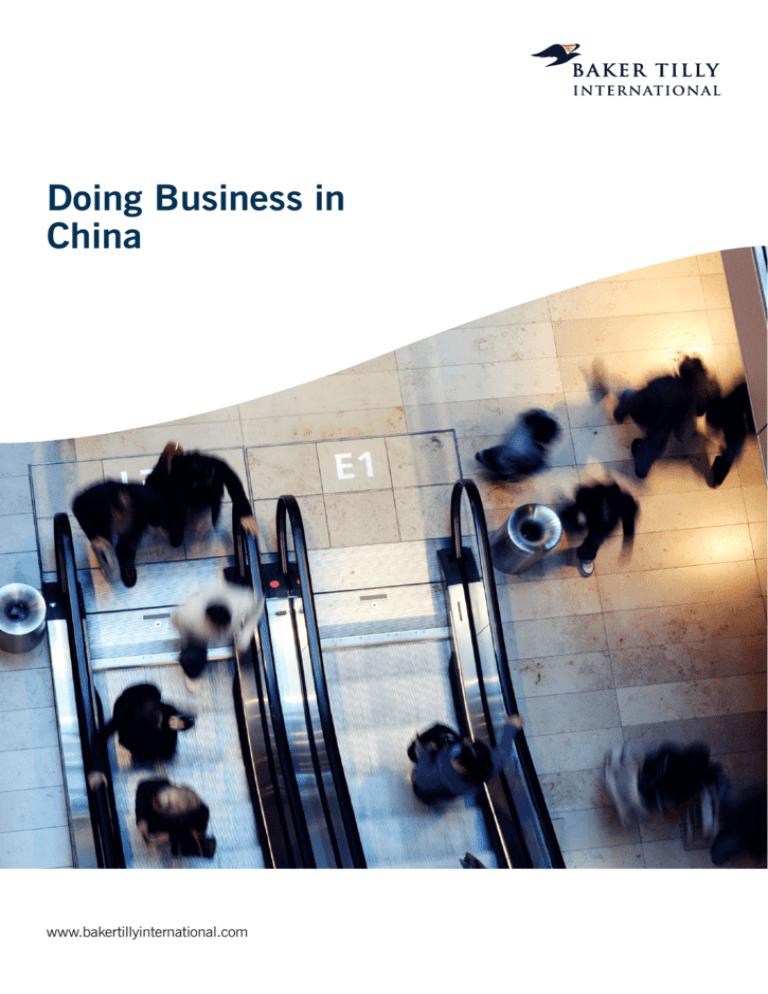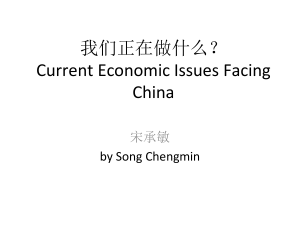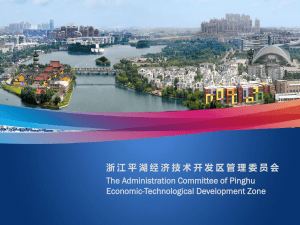
Doing Business in
China
www.bakertillyinternational.com
Contents
1 Fact Sheet
2
2 Business Entities and Accounting
2.1 General
2.2 Representative Office (RO)
2.3 Wholly Foreign-owned Enterprise (WFOE)
2.4 Equity Joint Venture (EJV)
2.5 Contractual Joint Venture (CJV)
2.6 Other Business Entities
2.7 Audit and Accounting Requirements
2.8 Filing Requirements
4
4
4
5
5
6
6
6
7
3 Finance and Investment
3.1 Investment Approval
3.2 Exchange Control
3.3 Banking and Sources of Finance
3.4 Investment Incentives
3.5 Research and Development (R&D)
3.6 Tariffs
8
8
9
9
10
10
10
4 Employment Regulations
4.1 General Employment Matters
4.2 Visas and Permits
11
11
12
5 Taxation
5.1 Corporate Income Taxes
5.2 Personal Taxes
5.3 Employment Related Costs and Taxes
5.4 Withholding Taxes
5.5 Value Added Tax (VAT)
5.6 Business Tax
5.7 Other Taxes
5.8 Tax Incentives for Businesses
13
13
14
15
15
16
16
17
18
Member Firm Contact Details
20
2
1 Fact Sheet
Geography
Location:
East Asia
Area:9,596,960km2
Land boundaries:
Afghanistan, Bhutan, Burma, India, Kazakhstan, Kyrgyzstan, Laos, Mongolia,
Nepal, North Korea, Pakistan, Russia, Tajikistan and Vietnam
Coastline:
Pacific Ocean; more specifically, East China Sea, Yellow Sea, South China Sea
and Korea Bay
Climate:
A notable monsoonal trait. Cold and dry in the winter; hot and wet in the
summer. It is hotter and more humid in the south and colder and dryer in the
north. The January mean temperature is much lower than that experienced
in other countries at the same latitude, whereas mean temperature in July is
much higher
Terrain:
Generally, highlands in the west and lowlands in the east. Various land forms
made up of highlands (33%), plateaux (26%), basins (19%), plains (12%) and
moors (10%)
Time zone:
GMT +8
People
Population:
1,351m (2012)
Ethnic groups:
Han people in the majority, with 55 ethnic minorities
Religion:
Buddhism is the predominant faith and Islam the second largest faith. China
allows freedom of worship for other religions
Language:
The official language is Mandarin (Pu Tung Hwa). Within the PRC there are a
number of local dialects and ethnic languages spoken and there are parts of
China where Mandarin is not the predominant or preferred spoken language.
Written Chinese characters are consistent and understood throughout China.
English is spoken by a small percentage of the population but is the most
common language used in international business. English is now taught in all
junior schools as a second language
Doing Business in
China
3
Government
Country name:
People’s Republic of China (PRC)
Government type:
Communist
Capital:
Beijing, with a population exceeding 20m
Administrative divisions:
The Chinese mainland is made up of 22 provinces, five autonomous regions and
four municipalities directly under the central government
Political situation
The Constitution of the PRC stipulates that the country’s central state organs
comprise six components: the National People’s Congress (NPC), the Presidency
of the PRC, the State Council, the Central Military Commission, the Supreme
People’s Court and the Supreme People’s Procuratorate. The NPC is the
fundamental decision-making body in China. The Communist Party of China
(CPC) is the country’s sole political party in power. The General Secretary of the
CPC is the Head of State.
Economy
GDP – per capita:
US$6,188 (2012)
GDP – real growth rate:
7.8% (2012)
Unemployment:
4.1% (2012)
Currency:
The Renminbi (RMB), denominated in units of Yuan (¥), Jiao and Fen (one Yuan
equals 10 Jiao or 100 Fen). The exchange rate is managed (fixed on a daily
basis) against all currencies
4
2 Business Entities and Accounting
2.1 General
The most common legal structures used for establishing a presence in the
PRC are:
• A representative office (RO)
• A wholly foreign-owned enterprise (WFOE)
• An equity joint venture (EJV)
• A contractual joint venture (CJV).
An investor establishing a foreign investment enterprise (FIE) is required to meet
a variety of minimum capital requirements, including:
• ¥500,000 typically required as minimum share capital, although this can
increase to ¥1m where VAT registration is required.
• US dollar or yuan paid-up capital requirements depending on the industry in
which the investment is being made.
• Paid-up capital requirements dependent on the total US dollar amount of the
investment being approved.
2.2 Representative
Office (RO)
An RO cannot invest in, or carry on business in, the PRC, nor can it enter into
sales or trade on its own account. It can act only as the representative of its
head office in a liaison, quality control, sourcing or similar role. Approval and
registration of an RO normally takes two to three weeks and is often used as an
intermediary step before establishing a WFOE.
Doing Business in
China
5
2.3 Wholly Foreign-owned
Enterprise (WFOE)
The legal entity most frequently used by foreign investors is the WFOE, which is
a limited liability company that is wholly owned by foreign investors. However,
the law and regulations restrict or prohibit the establishment of WFOEs in certain
industries. The legal representative of a WFOE has the power to represent the
enterprise and, therefore, the articles of association must spell out, in detail, the
scope of the representative’s authority.
Capital may be contributed in cash or tangible assets with a minimum 30% cash
contribution. When capital is contributed in instalments, an immediate 15%
contribution is required and the final instalment must be within two years of
issuing the business licence.
There is no mandatory management structure for a WFOE, but the articles
of association must define the structure in detail and specify procedures for
termination, liquidation and amendment of the articles.
2.4 Equity Joint Venture
(EJV)
An EJV is typically used for long-term projects and is formed jointly by
foreign and Chinese companies, enterprises, other economic organisations or
individuals. The duration of an EJV usually ranges from 10 to 30 years, but can
be 50 years or longer with government approval. The duration of an EJV can be
extended when it expires. An EJV is typically a limited liability company.
The profits and losses of an EJV are allocated according to the ratio of capital
contributions made by the EJV partners. A minimum 25% foreign participation
is required. Capital is contributed in the form of cash although, under certain
conditions, tangible or intangible assets can be contributed.
An EJV must have at least three directors, including a chairman and a vice
chairman. The directors must meet at least once a year and make all major
decisions. Some decisions require the unanimous agreement of the directors. An
EJV does not fix the number of managers, but must include a general manager
(no nationality requirement) and a deputy general manager.
6
2.5 Contractual Joint
Venture (CJV)
CJV structures are often adopted for shorter-term projects or build-operatetransfer projects, and are formed with joint capital or terms of co-operation
between foreign and Chinese companies, enterprises, other economic
organisations or individuals. A CJV can register as a company with limited
liability, but this is not mandatory.
Capital is contributed in an agreed ratio and may take the form of cash, land use
rights, technology (patented or unpatented), materials and equipment, trademarks
and other property rights. Parties to a CJV share profit in the ratio determined in
the contract and not according to investors’ respective contributions.
A CJV is governed by the Law on Co-operative Joint Ventures and requires a
venture to have either a board of directors or a joint management committee.
The chairman of the board or the head of the management committee serves as
the CJV’s legal representative.
2.6 Other Business Entities
The PRC has established the legal framework for other business structures such
as partnerships, but foreign investors have preferred to use investment vehicles
that provide them with greater legal certainty.
2.7 Audit and Accounting
Requirements
The mandatory accounting year is the calendar year. All FIEs are required to be
audited. Financial statements must be presented in Chinese in accordance with
Chinese generally accepted accounting principles (GAAP).
The PRC currently uses two accounting systems:
• New Chinese GAAP (NCGAAP), which is close to IFRS
• Old Chinese Accounting Standards (OCAS) and Accounting Regulations for
Business Enterprises (ARBE).
Companies listed on Chinese stock exchanges and unlisted large and medium size
companies are required to adopt NCGAAP. Unlisted small companies still apply
OCAS and ARBE. A conversion date for unlisted small companies has yet to be set.
Doing Business in
China
7
2.8 Filing Requirements
The annual business licence renewal process requires all enterprises in China
(including FIEs) to submit their financial statements and auditor’s report
(together with other documents specified in their business licence) to the
Administration of Industry and Commerce (AIC) in the taxpayer’s area for annual
inspection. The law provides that annual inspections are to be carried out by the
AIC from 1 March to 30 June each year.
8
3 Finance and Investment
3.1 Investment Approval
Traditionally, foreign investors had to obtain approval before establishing or
investing in the PRC; however, in order to encourage foreign direct investment
into China, the rules have been relaxed to some extent.
The PRC maintains a Foreign Investment Catalogue (FIC) to guide the approval
of FIEs. The FIC encourages investment in modern agriculture, high technology
industries, modern services and infrastructure.
Regulations categorise foreign investment as either encouraged, restricted,
prohibited or permitted. The FIC provides details of the first three categories,
while permitted projects are deemed to be all projects not listed.
The Catalogue of Encouraged Hi-tech Products for Foreign Investment
encourages investment in electronic information, software and outsourcing
services, aviation and spaceflight, advanced manufacture, biology, medicine
and medical appliances, new materials, new and high efficiency energy,
environmental protection, earth and ocean sciences, and applied nuclear
energy technology.
The FIE approval process typically involves 15 separate applications divided into:
• Investment approval, and
• Business registration.
The approval and registration process is completed at provincial government
level, although some investment proposals may require national government
approval. The application process can vary significantly from location to location
and can take two to three months, or longer, to complete. A business licence
must be renewed annually.
Doing Business in
China
9
3.2 Exchange Control
Foreign exchange controls allow convertibility on current account (ie foreign
exchange used by the enterprise for daily recurring transactions in the ordinary
course of business), impose controls on capital items (ie imports and exports of
capital), and supervise and manage the foreign exchange business of financial
institutions.
Technically, China has removed all restrictions on payments by enterprises for
imports, labour and services, repayment of interest on foreign debt and the
repatriation of profits, but offshore remittances require approval by the State
Administration of Foreign Exchange (SAFE). With the exception of trade goods,
approval is not provided unless an application is supported by documentation
including proof of taxation.
Approval of transactions on capital account is closely scrutinised by SAFE and
the investment approval authorities, and can be a time consuming process.
3.3 Banking and Sources
of Finance
The banking system comprises: state-owned or controlled banks, other banks,
and foreign-funded banks. State-owned and controlled banks constitute the
largest component of the banking system. Foreign banks can get approval to
incorporate in China and operate as Chinese banks. A number of foreign banks
have incorporated in the PRC.
Non-bank financial institutions include: trust and investment corporations,
securities companies, insurance companies, finance companies, leasing
companies and credit unions.
The banking system is highly liquid and most forms of business financing
are available. A foreign investor may find obtaining funding difficult or more
expensive until they have established good banking relationships. The
government closely manages the banking system and may impose lending
or capital restrictions on individual banks or the banking sector, affecting the
availability of financing from time to time.
10
3.4 Investment Incentives
Investment incentives are largely tax driven and are focused on designated
industries. See 5.8.
3.5 Research and
Development (R&D)
For R&D expenses incurred in the development of new technologies, new products
or new production techniques, a 50% additional deduction may be granted if the
expenses are not capitalised as intangible assets but are instead recorded directly
in an enterprise’s income statement for the current period. If the expenditures are
capitalised as intangible assets, 150% of the expenditures can be amortised.
Research expenditure for new technology, new products and new craftsmanship
are allowed an additional deduction of 50% of actual cost.
3.6 Tariffs
Import duties are generally imposed on imported goods. The rates imposed are
either general rates or preferential rates where the PRC has a reciprocal tariff
agreement with the exporting country. Customs duty and VAT are exempt on
equipment imports by an FIE which form part of its total approved investment.
Exemptions may also be available for imports encouraged under the FIC.
Export products manufactured by an enterprise, except those prohibited from
exportation by the state and those subject to other state regulations, are exempt
from export tariffs.
Imports necessary for an enterprise to produce exports are regarded by Customs
as bonded commodities.
11
4 Employment Regulations
For employment tax considerations, see 5.3.
4.1 General
Employment Matters
4.1.1 Employment law
Until 2008, employment law was governed by the Labour Law of the PRC.
While this law continues to remain in force today, employment law was reformed
with the introduction of the Employment Contract Law (ECL), which sought to
improve working conditions in China.
In the case of contracts signed before 2008, the provisions of the ECL supersede
those of the Labour Law should any dispute arise.
Various other laws provide for such matters as mediation and arbitration in
employment disputes, and employee representation.
4.1.2 Employment contract
The law stipulates that employment contracts should be in writing. Where a
contract in writing is not provided before employment, one must be concluded
and provided within one month of the employee commencing work.
Employment contracts must contain information as prescribed by the ECL, including:
• The duration of the contract
• Scope of work
• Place of work
• Working hours, rest and leave
•Pay
• Social insurance, and
• Labour protection, working conditions and protection against occupational
hazards.
A probation period can be included in the contract.
Standard working hours are eight hours per day, up to 40 hours per week.
While overtime pay is specified in the Labour Law (at rates of between 150%
and 300% of usual pay), employers can seek government approval to introduce
alternative working hours systems that eliminate or restrict entitlement to
overtime payments.
12
Employees are entitled to paid annual leave of between five and 15 working
days, depending on their length of service, plus public holidays.
Minimum wages are set at local government level.
4.1.3 Employee representation
All trade unions are affiliated with the All-China Federation of Trade Unions,
which effectively brings them under government control. However, unions in
China tend to act as intermediaries between employers and employees, rather
than working in the full interests of the employees.
4.2 Visas and Permits
Foreigners visiting China for business must approach Chinese business
associates and obtain a letter of invitation. A visa may then be obtained from an
embassy or consulate.
An FIE intending to employ an expatriate must apply to the authorities for an
Employment Licence for Expatriates (ELE). Once the ELE is issued, the FIE
may then apply for the Professional Visa Notification (PVN). The expatriate
then applies for a Professional Visa with a copy of the PVN and the original of
the ELE. Within 15 days of entering China, the expatriate must apply for an
Employment Certificate (EC), which is used by the expatriate to apply for a
Residence Certificate (RC). It is common for an expatriate employee to be in
China on a business visa during this process.
Foreigners seeking employment can enter China on an occupational visa, but can
only be employed after obtaining the EC and RC.
13
5 Taxation
5.1 Corporate Income
Taxes
There is no definition of a company in Chinese tax law and taxes on trading
income are imposed on business enterprises generally.
Resident enterprises, defined as those which are established in China, or which
are established in a foreign country but which have their place of effective
management in China, are taxed on their worldwide income.
Other enterprises are taxed only on their income from sources in China, subject
to the terms of any relevant double tax treaty.
The Special Administrative Regions of Hong Kong and Macau are not within the
tax jurisdiction of China, and enterprises established in the Regions are subject
to tax in China only if they have their place of effective management there or if
they have income arising there.
The general rate of corporate income tax is 25%.
A reduced rate of 20% applies to enterprises with annual taxable income of less
than ¥300,000. Other requirements must also be met, including
• Total assets of less than ¥30m and fewer than 100 employees for industrial
enterprises, or
• Total assets of less than ¥10m and fewer than 80 employees for all other
enterprises.
Micro-enterprises (ie businesses with annual income of no more than ¥60,000
for calendar years 2012 to 2015 (¥30,000 previously)) benefit from a 50%
exemption based on the 20% rate, giving an effective rate of 10%.
Capital gains are taxed in the same way as income.
Enterprises may carry forward losses for relief against future profits for up to
five years. There is no provision for losses to be carried back for relief against
earlier profits.
There is no tax consolidation facility for groups of enterprises.
The tax year is the calendar year; businesses cannot choose an alternative tax
year. Tax returns must be filed within five months of the tax year-end (ie for tax
year 2013, by 31 May 2014).
Tax liabilities must be paid on an estimated basis each month or quarter. Any
balancing amount due must be paid within five months of the tax year-end (thus,
for tax year 2013, the balancing payment is due by 31 May 2014). The period
for filing final tax returns can be extended in special circumstances, provided it is
applied for within the specified filing period.
14
5.2 Personal Taxes
Resident individuals are generally taxed on their worldwide income.
Foreign nationals who are resident in China for less than five years are usually
taxed only on their income from sources within China.
Non-resident individuals are taxed only on their income from sources in China.
Resident individuals are taxed at the following rates on wage and salary income:
Monthly Taxable Income
Tax Rate
¥0 – ¥1,500
3%
¥1,501 – ¥4,500
10%
¥4,501 – ¥9,000
20%
¥9,001 – ¥35,000
25%
¥35,001 – ¥55,000
30%
¥55,001 – ¥80,000
35%
Over ¥80,000
45%
For income from individual industrial and commercial households (ie private
businesses and sole proprietors), the tax rates are as below:
Annual Taxable Income
Tax Rate
¥0 – ¥15,000
5%
¥15,001 – ¥30,000
10%
¥30,001 – ¥60,000
20%
¥60,001 – ¥100,000
30%
Over ¥100,000
35%
The standard monthly deduction against taxable income is ¥3,500 with an
additional monthly deduction of ¥1,300 for certain individuals, such as foreign
nationals and expatriate employees.
Capital gains are taxed as income, with the exception of gains realised from
selling property, in which case the gain is taxed at 20%.
There are no inheritance, gift or wealth taxes.
Doing Business in
China
15
5.3 Employment Related
Costs and Taxes
5.3.1 Fringe benefits
Fringe benefits which do not represent “money” or “money’s worth”, and are
not convertible into cash, are not taxed in the hands of the employee. The
manner in which benefits are granted should not amount to the discharging of an
employee’s liability by an employer. Otherwise, the benefit is taxable.
For expatriate employees, housing, meal, laundry, relocation, language training,
a portion of child education and reasonable travel allowances received in noncash form, or as reimbursement for expenses incurred, are provisionally exempt
from individual income tax in China.
5.3.2 Social security costs
Employers are generally required to make social security contributions to insurance
funds for pensions, medical, work-related injuries, unemployment and maternity.
Employees are generally required to make social security contributions to insurance
funds for pension, medical and unemployment. The rates vary from city to city.
5.4 Withholding Taxes
5.4.1 Domestic payments
Dividends, interest and royalties paid to resident companies, or to non-resident
companies with a permanent establishment (PE) in China, are generally included
in taxable corporate income (headline rate 25%). Certain qualifying dividends
from equity investment gains are exempt.
Where such payments are made to individuals, a general withholding tax rate of
20% applies, with the following exceptions:
• Interest payments made from savings accounts are exempt
• The rate in relation to listed shares depends on the period for which they
are held:
• 5% if held for more than one year
• 10% if held for between one month and one year, and
• 20% if held for one month or less.
16
5.4.2 Payments abroad
Dividends, interest and royalties paid to non-resident companies without a PE in
China, or with a PE to which incomes are not attributed, are subject to a 10%
withholding tax (reduced from 20% for an unspecified period since 2000).
Dividends paid out of pre-2008 profits are exempt from withholding tax.
The payment of technical assistance fees can in some circumstances be classed
as royalties and accordingly become subject to withholding tax.
For payments made to recipients in countries with which China has a double tax
treaty, the withholding tax may be reduced or eliminated.
5.5 Value Added Tax (VAT)
VAT is levied on the selling price of goods and of some services, and on the value
of imported goods. Business enterprises generally must register for the tax, but
individuals with a low turnover are exempt. There is no registration threshold for
resident and non-resident businesses.
The standard VAT rate is 17%, although reduced rates of 0%, 3%, 6%, 11%
and 13% apply to certain goods and services.
Enterprises can usually recover the VAT with which they themselves are charged,
but there are some exceptions.
Period VAT returns are filed monthly. The deadline for filing is 15 days after the
end of the period.
From 1 August 2013, VAT has been suspended for small businesses with
monthly turnover below ¥20,000 and for cross-border services; at the time of
announcements, no end dates were given.
5.6 Business Tax
Business tax is charged on the selling price of goods and services which are
not subject to VAT, but with several exceptions. Rates vary, and include 3% for
construction, telecommunication and transportation services, 5% for sales of
property and for certain service industries, and up to 20% for the entertainment
industry. Unlike VAT, enterprises cannot recover the business tax with which they
themselves are charged.
From 1 August 2013, business tax has been suspended for small businesses
with monthly turnover below ¥20,000; at the time of announcement, no end
date was given.
Doing Business in
China
17
5.7 Other Taxes
5.7.1 Deed tax
Contracts for the sale or lease of real estate are subject to deed tax at rates
ranging from 3% to 5%. The tax is generally based on the transaction value or
the market value.
5.7.2 Land appreciation tax
Gains made from the transfer of real estate rights are subject to land appreciation
tax at rates ranging from 30% to 60%.
5.7.3 Other real estate taxes
Enterprises occupying real estate in towns and cities must pay an urban land use
tax to the local government authority. The tax is calculated by reference to the
size of the property occupied, with the rate per square metre varying depending
on the size of the town or city.
Enterprises must also pay a house property tax to local authorities. The tax
applies to all buildings occupied, not only houses, and is based on the assessed
value of the property or the rental income it generates.
5.7.4 Stamp duty
Stamp duty is charged on documents evidencing transactions, generally at
rates from 0.005% to 0.1% of the capital value. Transfers of shares listed on a
domestic stock exchange are charged at 0.1% of their value.
5.7.5 Environment tax
There is currently no general tax based on environmental issues, although there
is a limited pollutant emission surcharge in place.
5.7.6 Consumption tax
Consumption (excise) tax is imposed at various rates on a number of goods,
including tobacco, alcoholic drinks, certain automobiles and motors, petrol,
diesel oil, vehicle tyres, cosmetics, luxury jewellery and fireworks.
18
5.8 Tax Incentives for
Businesses
5.8.1 Research and development
(R&D) expenditure
For R&D expenses incurred in the development of new technologies, new
products or new production techniques, a 50% additional deduction may be
granted if the expenses are not capitalised as intangible assets but are instead
recorded directly in an enterprise’s income statement for the current period. If
the expenditures are capitalised as intangible assets, 150% of the expenditures
can be amortised.
Enterprises which produce high technology goods or services falling within a
government prescribed list are eligible for a reduced 15% rate of tax provided
conditions are satisfied. The conditions are extensive, and relate, for example,
to the ratio of R&D expenditure to turnover, the proportion which sales of high
technology goods and services bears to total turnover, the ratio of research staff
to total staff, and the proportion of research staff with a university degree.
5.8.2 Environmental sector
Businesses providing energy-saving services are eligible for full corporate income
tax exemptions in the first three years, and a corporate income tax rate of 12.5%
for the second three years. Eligible years are calculated from the first year in
which business income arises.
Those in the energy saving, environment protection and production safety industries
can use 10% of their investments in equipment to offset their income tax payable,
and this can be carried forward for five years. Businesses in the comprehensive
resources utilisation sector (which aims to recycle and reuse industrial waste
materials) can benefit from a 10% corporate income tax exemption.
Doing Business in
China
19
5.8.3 Other incentives
Businesses involved in agrarian industries and those appointed as reserve
stockholders of grain, oil, sugar, cotton and meat benefit from corporate income
tax exemptions.
A reduced income tax rate of 15% applies for high or new technology ventures
eligible for key support from the state.
Venture capital enterprises may be eligible for a 70% reduction of the amount
invested from their taxable income if they have invested in encouraged small or
medium-sized high technology enterprises for more than two years.
Newly established software or integrated circuit design businesses are exempted
from corporate income tax for the first two profitable years and enjoy a 50%
reduction in corporate income tax for the subsequent three years.
Businesses engaged in agriculture, fisheries and forestry are subject to
reduced rates of tax. Also, businesses undertaking public infrastructure and
environmental protection projects can benefit from reduced rates of tax on their
income from those projects.
25 Farringdon Street
London EC4A 4AB
United Kingdom
T: +44 (0)20 3201 8800
F: +44 (0)20 3201 8801
info@bakertillyinternational.com
www.bakertillyinternational.com
Baker Tilly is the trademark of the UK firm, Baker Tilly UK Group LLP, used under licence.
Like us on Facebook
© 2013 Baker Tilly International Limited, all rights reserved
Join our group








